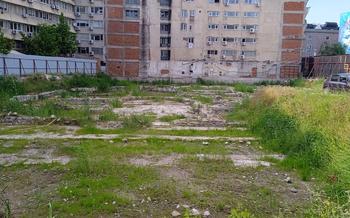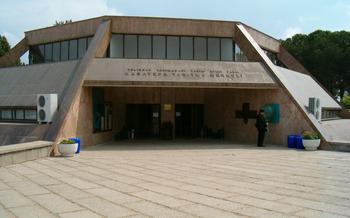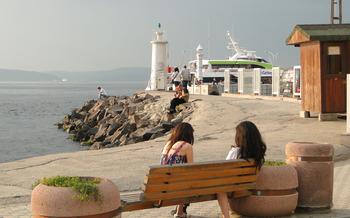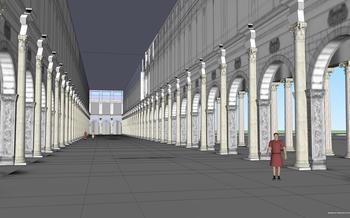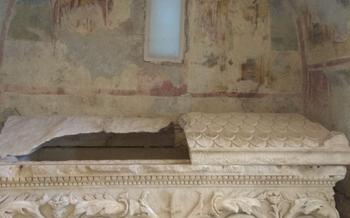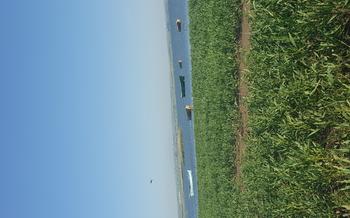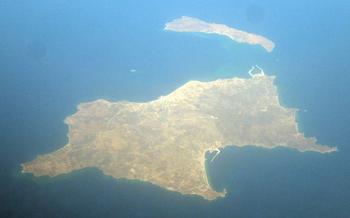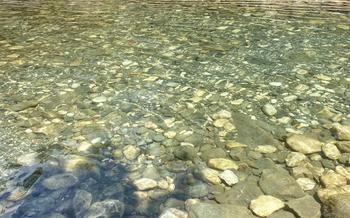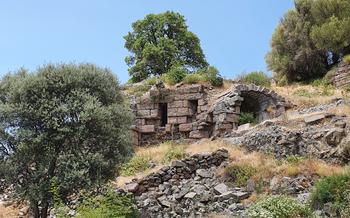
The Ancient City of Myrina
- History of Myrina
- Location of Myrina
- Archaeological Excavations
- Temple of Athena: A Testament to Ancient Greek Architecture
- The Theater of Myrina: A Stage for Ancient Performances
- Agora of Myrina
- City Walls of Myrina - Guardians of the Ancient City
- Residential Areas of Myrina
- Museum of Myrina
- Festivals and Events
- Local Cuisine:
- Natural Beauty
- Accommodation
- Transportation
- Insider Tip: Making the Most of Your Visit to Myrina
History of Myrina
Myrina, an ancient Greek city, emerged in the 7th century BC, leaving an indelible mark on the region's history. Over the centuries, it fell under the sway of various civilizations, each leaving behind its unique imprint. The Persians, Romans, and Byzantines all played a role in shaping Myrina's destiny. However, natural disasters and invasions in the 14th century led to its abandonment, leaving behind a treasure trove of ruins for modern-day explorers to discover.
Location of Myrina
Myrina, an ancient Greek city with a rich history, is nestled on the shores of the Gulf of Edremit in the province of Balıkesir, Turkey. Once part of the historical region of Aeolis, Myrina's strategic location made it a significant port city and a vital hub for trade and cultural exchange. Today, it's easily accessible by road, with well-maintained highways connecting it to major cities like Istanbul and Izmir, inviting travelers to explore its captivating ruins and immerse themselves in its rich past.
Archaeological Excavations
The ancient city of Myrina has been the subject of extensive archaeological excavations since the 19th century. These excavations have brought to light a wealth of ruins and artifacts that provide valuable insights into the city's rich history and culture. Among the most significant discoveries are the remains of temples, theaters, an agora, city walls, and residential areas.
The Temple of Athena, dedicated to the patron goddess of the city, stands as one of the most impressive structures in Myrina. Its well-preserved Doric columns and intricate architectural details offer a glimpse into the city's architectural prowess. The Theater of Myrina, built in the 2nd century AD, is another remarkable find. This large and well-preserved theater, capable of accommodating thousands of spectators, was used for theatrical performances, musical events, and public gatherings.
The agora, the central marketplace and gathering place of the ancient city, has also been extensively excavated. Surrounded by shops, workshops, and public buildings, the agora was a vibrant hub of economic and social activity. The city walls, constructed to protect Myrina from invaders, feature massive stone blocks and impressive gateways, offering panoramic views of the surrounding landscape.
Excavations in the residential areas of Myrina have revealed the remains of houses with courtyards, mosaics, and frescoes, providing a glimpse into the daily life of the city's inhabitants. Streets and alleyways connect different parts of the city, creating a sense of urban planning and organization.
The artifacts unearthed during these excavations, including sculptures, pottery, and coins, are displayed in the Museum of Myrina, located near the ancient city. These artifacts offer further insights into the history, culture, and artistic traditions of Myrina and its inhabitants. Ongoing excavations continue to shed light on the rich and complex past of this ancient city, making Myrina a fascinating destination for history buffs and archaeology enthusiasts.
Temple of Athena: A Testament to Ancient Greek Architecture
Standing tall amidst the ruins of Myrina, the Temple of Athena is a testament to the architectural prowess of the ancient Greeks. Dedicated to the goddess Athena, the protector of the city, this temple was a sacred site for the people of Myrina. Built in the 5th century BC, the temple features well-preserved Doric columns that showcase the refined craftsmanship of the era. Intricate carvings and moldings adorn the temple's facade, depicting scenes from Greek mythology and paying homage to the goddess Athena. Despite the passage of time and the ravages of nature, the Temple of Athena remains an awe-inspiring sight, offering a glimpse into the religious beliefs and artistic achievements of the ancient Greeks.
The Theater of Myrina: A Stage for Ancient Performances
The Theater of Myrina is an impressive testament to the cultural and artistic achievements of this ancient city. Built in the 2nd century AD, this large and well-preserved theater once played host to a variety of performances, from theatrical productions to musical concerts.
With a seating capacity of thousands, the theater provided ample space for both local residents and visitors to enjoy these events. The stage area features intricate architectural details, including columns, friezes, and niches, hinting at the grandeur of the performances that once took place here.
Imagine the atmosphere as the actors graced the stage, their voices resonating through the theater. The audience would have been captivated by the stories unfolding before them, transported to different worlds and emotions. The theater also served as a venue for public gatherings and speeches, allowing the citizens of Myrina to engage in political and social discussions.
Today, the Theater of Myrina stands as a reminder of the vibrant cultural life that flourished in this ancient city. Visitors can explore the theater's ruins, marvel at its architectural features, and imagine the spectacle of performances that once filled this space with life and energy.
Agora of Myrina
The agora, or marketplace, was the bustling heart of ancient Myrina. Located at the center of the city, it served as a vibrant hub for economic and social activities. Surrounded by shops, workshops, and public buildings, the agora was a place where locals and visitors alike gathered to conduct business, exchange news, and socialize.
Excavations of the agora have revealed the remains of numerous structures, including shops, warehouses, and administrative buildings. The shops, with their well-preserved counters and storage spaces, offer a glimpse into the commercial activities that took place here. Artisans and merchants displayed their wares, from pottery and jewelry to textiles and agricultural products. The agora was also home to workshops, where craftsmen produced goods such as pottery, metalwork, and textiles.
Public buildings, such as the bouleuterion (council house) and the prytaneion (government building), were also located in the agora. Here, the city's officials conducted meetings, made decisions, and received foreign dignitaries. The prytaneion also served as a center for religious ceremonies and public feasts.
The agora was not just a place of commerce and administration; it was also a social and cultural hub. People gathered here to exchange news, share stories, and participate in public events. Festivals, religious ceremonies, and political rallies were often held in the agora, bringing the community together.
Today, the ruins of the agora offer visitors a glimpse into the bustling and vibrant life of ancient Myrina. The well-preserved remains of shops, workshops, and public buildings provide a tangible connection to the past, allowing visitors to imagine the sights, sounds, and smells of this ancient marketplace.
City Walls of Myrina - Guardians of the Ancient City
The ancient city of Myrina was once a fortified stronghold, protected by imposing city walls that stretched for miles. These walls were constructed using massive stone blocks and featured impressive gateways that allowed for controlled access to the city. The walls served as a defensive barrier against invaders and provided a sense of security to the inhabitants of Myrina.
Today, the ruins of these city walls stand as a testament to the city's rich history and architectural prowess. Visitors can explore the remains of these fortifications and marvel at the engineering skills of the ancient builders. The walls offer panoramic views of the surrounding landscape, allowing visitors to appreciate the strategic location of Myrina, which once commanded the Gulf of Edremit.
As you wander along the ancient walls, you can imagine the hustle and bustle of daily life in Myrina, with people entering and exiting the city through these grand gateways. The walls served as more than just a defensive structure; they also symbolized the city's autonomy and independence.
Whether you are a history buff, an architecture enthusiast, or simply someone who appreciates stunning views, the city walls of Myrina are a must-see when exploring this ancient city. Their grandeur and historical significance make them an integral part of the Myrina experience.
Residential Areas of Myrina
Excavations in Myrina have revealed the remains of residential neighborhoods, providing a fascinating glimpse into the daily lives of its ancient inhabitants. These neighborhoods feature houses with courtyards, decorated with intricate mosaics and frescoes. The streets and alleyways that connect these dwellings offer a sense of the city's layout and vibrant atmosphere.
The houses themselves vary in size and design, reflecting the different social and economic status of Myrina's residents. Some houses boast spacious courtyards, adorned with gardens and fountains, while others are more modest in size. The intricate mosaics and frescoes that adorn the floors and walls of these homes showcase the artistic talents of Myrina's artisans and provide valuable insights into the tastes and preferences of its people.
Exploring the residential areas of Myrina is like stepping back in time, imagining the hustle and bustle of daily life in this ancient city. The narrow streets, lined with houses and shops, would have been filled with the sounds of people going about their daily activities - merchants hawking their wares, children playing, and the clatter of pottery workshops.
These neighborhoods offer a unique perspective on the social and cultural fabric of Myrina, allowing visitors to connect with the lives of its past inhabitants and gain a deeper understanding of this remarkable ancient city.
Museum of Myrina
Located near the ancient city, the Museum of Myrina is a treasure trove of artifacts unearthed from the excavations. This modest yet fascinating museum provides a glimpse into the rich history and culture of Myrina. As you wander through its galleries, you'll encounter an array of relics, including sculptures, pottery, coins, and jewelry. These artifacts offer valuable insights into the daily lives, artistic traditions, and religious practices of Myrina's ancient inhabitants. The museum also houses a collection of inscriptions that shed light on the city's political and social organization. Whether you're a history buff, an art enthusiast, or simply curious about the past, the Museum of Myrina is a must-visit destination.
Festivals and Events
Myrina's rich history and vibrant culture come alive during its numerous festivals and events. Throughout the year, the ancient city and its surroundings host a variety of celebrations that offer a unique glimpse into the region's traditions and heritage.
One of the most popular events is the Myrina Theater Festival, held annually in July and August. This prestigious festival showcases a diverse range of theatrical performances, from ancient Greek dramas to contemporary plays. The festival takes place in the city's ancient theater, creating a magical atmosphere that transports audiences back in time.
Another highlight is the Myrina Olive Oil Festival, held in October or November. This festival celebrates the region's renowned olive oil production, with exhibitions, tastings, and workshops. Visitors can sample a variety of olive oil-based dishes, learn about traditional harvesting and pressing techniques, and purchase high-quality olive oil directly from local producers.
For those interested in music, the Myrina Music Festival features a lineup of talented musicians from Turkey and abroad. Held in August or September, the festival presents a mix of traditional and contemporary music, from classical to jazz and rock.
Throughout the year, Myrina also hosts cultural events such as art exhibitions, traditional dance performances, and literary readings. These events provide opportunities to engage with local artists, learn about Turkish culture, and make meaningful connections with the community.
Attending festivals and events in Myrina is a fantastic way to experience the city's vibrant atmosphere and immerse yourself in its rich cultural heritage. Make sure to check the festival calendar before your visit to plan your trip accordingly and enjoy the unique experiences that Myrina has to offer.
Local Cuisine:
Indulge in the culinary delights of Balıkesir province, renowned for its rich and flavorful cuisine. Begin your culinary journey with the iconic ayvalık tostu, a toasted bread delicacy topped with a delectable blend of cheese and tomatoes. Savor the succulent midye dolma, tender mussels stuffed with aromatic rice and herbs, a local specialty that tantalizes taste buds. Explore the world of zeytinyağlı dishes, a culinary symphony of fresh, seasonal vegetables lovingly prepared with the region's finest olive oil. These dishes, infused with the essence of the Mediterranean, are a testament to the region's culinary heritage. Immerse yourself in the vibrant flavors of Balıkesir, where every bite tells a story of culture, tradition, and the bounty of nature.
Natural Beauty
The region surrounding Myrina is a treasure trove of natural beauty, waiting to be explored. Immerse yourself in the picturesque landscapes that embrace this ancient city. Stroll along the pristine beaches that grace the coastline, where the turquoise waters beckon you for a refreshing swim. Take a leisurely hike through verdant olive groves, where the rustling leaves create a soothing symphony. Discover charming villages nestled amidst rolling hills, where time seems to stand still. Embrace the tranquility of nature as you explore the hidden gems that await you in this enchanting corner of Turkey. Whether you seek adventure or relaxation, the surroundings of Myrina offer a sanctuary for every traveler's soul.
Accommodation
Myrina and its surroundings offer a range of accommodation options, catering to different budgets and preferences. Whether you seek a cozy guesthouse, a traditional Turkish house, or a luxurious resort, you'll find something that suits your needs.
For a budget-friendly option, consider staying in a guesthouse or hostel. These establishments provide basic but comfortable accommodations at affordable rates. Many guesthouses offer shared dormitories, while others have private rooms.
If you prefer a more authentic experience, opt for a traditional Turkish house. These charming accommodations often feature local architecture, intricate tilework, and cozy courtyards. They provide a glimpse into Turkish culture and hospitality.
For those seeking luxury and indulgence, several upscale resorts are located near Myrina. These resorts offer modern amenities, such as swimming pools, spas, and fine dining restaurants. They also provide stunning views of the surrounding landscape.
Remember to book your accommodation in advance, especially during the peak tourist season (June-August), to secure your preferred choice. Online booking platforms and local travel agencies can assist you in finding and reserving your ideal accommodation.
Transportation
Myrina enjoys excellent connectivity, making it easily accessible from various parts of Turkey. Buses and minibuses operate regularly from major cities and towns, ensuring a convenient and affordable mode of transport. For those seeking greater flexibility, taxis and rental cars are readily available. Whether you prefer the ease of public transportation or the freedom of a private vehicle, getting to and around Myrina is a breeze.
Insider Tip: Making the Most of Your Visit to Myrina
To ensure a memorable and enjoyable experience, consider these insider tips:
-
Beat the Heat: Avoid exploring the ancient city during the scorching midday sun. Aim to visit early in the morning or late in the afternoon when temperatures are more pleasant.
-
Comfortable Footwear: The ancient city features uneven terrain, so wear sturdy and comfortable shoes to navigate the site safely and comfortably.
-
Capture the Beauty: Remember to bring your camera to capture the stunning ruins, picturesque landscapes, and panoramic views. The ancient city of Myrina offers endless opportunities for capturing breathtaking photographs.
